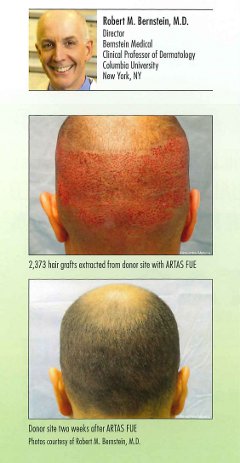Robert M. Bernstein MD, FAAD and Christine M. Shaver MD, FAAD of Bernstein Medical attended the 26th World Congress of the International Society of Hair Restoration Surgeons (ISHRS). At the congress, Dr. Bernstein introduced the newest robotic technology in the field of hair transplantation, the ARTAS iX, to an audience of over 550 hair restoration physicians.
Dr. Bernstein Introduces the ARTAS iX
Dr. Bernstein explains that the ARTAS iX now automates the implantation step of a hair transplant procedure by utilizing totally new hardware and software algorithms. The newly designed operating chair provides more flexibility for the surgeon and more comfort for the patient. This ARTAS iX also improves the accuracy and efficiency of the robotic FUE procedure.
With implantation, three of the four aspects of a hair transplant (excision, site creation, implantation) have now been successfully automated. Only graft extraction is left as the remaining step.
How Implantation Works
While performing an FUE procedure with the ARTAS iX, harvested grafts are loaded — 25 at a time – into rectangular cartridges. These cartridges are then inserted into the arm of the robot that implants the grafts directly into the scalp. A major advantage of using cartridges, rather than the manual technique, is more delicate handling of the grafts with less risk of graft injury. When grafts are implanted manually, they are typically grasped by the bulb, or just below the sebaceous glands, and then brought into the incision risking considerable damage in the process. With ARTAS iX, grafts are held at the epidermal end and then gently placed into the cartridge. This technique eliminates unnecessary injury to the growth of the transplanted hair by avoiding the lower and mid-portions of the follicles.
With the use of the ARTAS iX, the physician digitally creates a recipient site plan that communicates directly with the robot. The doctor programs the specific size, distribution, density, direction, and angle of the sites for the follicular unit grafts. The ARTAS iX’s vision system identifies where the grafts are to be placed, using the fiducials on the scalp as guides, and leads the robotic arm into position. Once the system automatically orients itself over the patient’s recipient area, implantation begins. The ARTAS iX can implant up to 500 grafts per hour.
ARTAS Robotic Hair Transplants at Bernstein Medical
Bernstein Medical was one of the first hair restoration practices in the world to use the ARTAS robot for FUE, a procedure pioneered by Dr. Bernstein and his colleague Dr. William Rassman. Bernstein Medical is a beta-test site for the ARTAS robotic systems. In 2013, Bernstein Medical was named an ARTAS Clinical Center of Excellence. Bernstein Medical is the first practice to offer the ARTAS iX.
Posted by



 A 2014 study in the journal Dermatologic Surgery measured follicular unit transection (follicle damage) during the extraction step of a robotic follicular unit extraction (R-FUE) procedure. The study found that robotic transection rates, using the ARTAS Robotic System, compared favorably with non-robotic (manual) FUE transection rates. ((Avram MR, Watkins SA. “Robotic follicular unit extraction in hair transplantation.” Dermatol Surg. 2014 Dec;40(12):1319-27))
A 2014 study in the journal Dermatologic Surgery measured follicular unit transection (follicle damage) during the extraction step of a robotic follicular unit extraction (R-FUE) procedure. The study found that robotic transection rates, using the ARTAS Robotic System, compared favorably with non-robotic (manual) FUE transection rates. ((Avram MR, Watkins SA. “Robotic follicular unit extraction in hair transplantation.” Dermatol Surg. 2014 Dec;40(12):1319-27))








